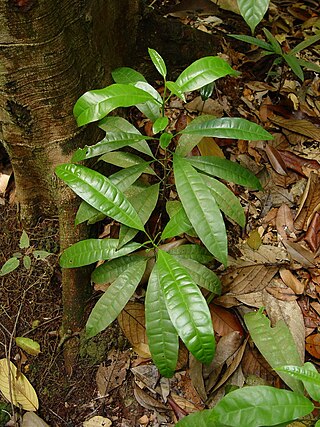Cotylelobium melanoxylon is a tree in the family Dipterocarpaceae. The specific epithet melanoxylon means "black wood", referring to the dark colour of the tree's wood. It was first described by Joseph Dalton Hooker in 1860 as Anisoptera melanoxylon and transferred to Cotylelobium by Jean Baptiste Louis Pierre in 1889. It is the provincial tree of Surat Thani Province, Thailand.
Mastixia glauca is a tree in the family Nyssaceae. The specific epithet glauca is from the Greek meaning "bluish-grey", referring to the colour of the leaf underside.
Melicope subunifoliolata is a plant of Borneo in the family Rutaceae. The specific epithet subunifoliolata is from the Latin meaning "nearly one leaf", referring to the almost unifoliolate leaves.
Parinari argenteo-sericea is a tree of Borneo in the family Chrysobalanaceae. The specific epithet argenteo-sericea is from the Latin meaning "silvery silky", referring to the pubescence of the inflorescence and flowers.
Kopsia pauciflora is a tree in the family Apocynaceae. The specific epithet pauciflora means "few-flowered".
Dipterocarpus lowii is a tree in the family Dipterocarpaceae.
Symplocos anomala is a plant in the family Symplocaceae.
Barringtonia conoidea is a plant in the family Lecythidaceae.
Madhuca malaccensis is a tree in the family Sapotaceae. It is named after Malacca in Peninsular Malaysia.
Madhuca motleyana is a tree in the family Sapotaceae. It is named for engineer and naturalist James Motley, who lived and worked in Borneo in the 1850s.
Madhuca silamensis is a tree in the family Sapotaceae. It is named for Mount Silam in Borneo.

Palaquium gutta is a tree in the family Sapotaceae. The specific epithet gutta is from the Malay word getah meaning "sap or latex". It is known in Indonesia as karet oblong.
Glyptopetalum quadrangulare is a plant in the family Celastraceae. The specific epithet quadrangulare means "four-angled", referring to the winged twigs.

Maclurodendron porteri is a tree in the family Rutaceae.
Melicope confusa is a tree in the family Rutaceae.

Melicope denhamii is a plant in the family Rutaceae. It is named for the 19th century Royal Navy captain Henry Mangles Denham.
Melicope glabra is a tree in the family Rutaceae. The specific epithet glabra is from the Latin meaning "hairless".

Melicope triphylla is a plant in the family Rutaceae. The specific epithet triphylla is from the Greek meaning "three leaf", referring to the trifoliolate leaves.
Glycosmis macrantha is a tree of Borneo in the family Rutaceae. The specific epithet macrantha is from the Greek meaning "large flower".
Glycosmis superba is a plant of Borneo in the family Rutaceae. The specific epithet superba is from the Latin meaning "splendid", referring to the leaves.





